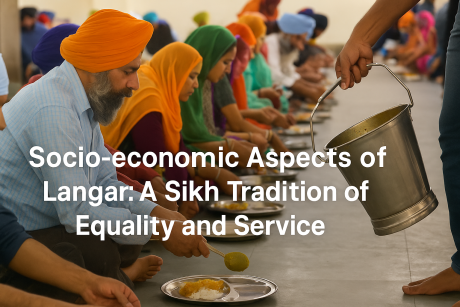Langar: Sikhism's Kitchen for Equality and Service
CHAIFRY POT
Chaifry
7/6/20257 min read


Introduction
Langar, the community kitchen integral to Sikh Gurdwaras, is more than a place to provide free meals; it is a profound socio-economic institution rooted in Sikhism’s core principles of equality, service, and community welfare. Initiated by Guru Nanak Dev Ji, Langar embodies the ethos of “Wand Chhakna” (sharing with others) and serves as a practical manifestation of social equality and economic justice (Singh, 2008, p. 27). The term “Langar,” derived from Persian, originally referred to a public kitchen established for followers and dependents, often as an asylum for the poor or a monastery for Sufi Darvesh (Singh, 2008, p. 28).
In Sikhism, it has evolved into a cornerstone of the faith, symbolizing equity and inclusiveness. This article explores the socio-economic dimensions of Langar, highlighting its role in fostering social cohesion, challenging caste hierarchies, and promoting equitable resource distribution.
Social Aspects of Langar
Promoting Social Equality Langar is a cornerstone of Sikhism’s commitment to social equality. By inviting people of all castes, religions, and backgrounds to sit together in a pangat (row) and share a meal, Langar dismantles social barriers. Guru Nanak Dev Ji established Langar to break the rigid caste system prevalent in India, encouraging people to dine together irrespective of their social status (Singh, 2008, p. 29). He set up a Gurdwara of bread at Kartar Pur, where people brought corn and fuel to prepare a common meal for the entire community, taking practical steps to create caste-free community kitchens (Singh, 2008, p. 29). This practice, institutionalized by Guru Amar Das with the principle of “Pahle Pangat, Pacche Sangat” (food first, congregation next), ensures that no one is excluded, fostering a sense of unity and shared humanity (Singh, 2008, p. 30).
The act of sitting in a pangat symbolizes equality, as all individuals, regardless of wealth, caste, or creed, partake in the same meal. This tradition directly challenges social hierarchies and promotes inclusiveness. As Guru Gobind Singh emphasized, “Realise that the human race is one” (Singh, 2008, p. 29). Guru Granth Sahib reinforces this principle in the following Shabd by Guru Nanak Dev Ji:
“Sabh iko ik niraṅkār hai. Nā koī jāti nā koī baran.” (All are one, from the One Formless Lord.
There is no caste, no color. (SGGS, Ang 349). This Shabd underscores the oneness of humanity, aligning with Langar’s mission to erase distinctions based on caste or social status, making the act of eating together a radical statement against discrimination (Singh, 2008, p. 29).
Community Service and Seva
Langar is deeply intertwined with the Sikh concept of seva (selfless service). Sikhs, irrespective of their socio-economic status, participate in preparing, serving, and cleaning up after meals. This voluntary service, known as karseva, is considered a sacred duty and a path to spiritual growth. Guru Amar Das noted, “He who is oriented towards God finds repose and joy in service” (Singh, 2008, p. 30). By engaging in tasks such as cooking, serving food, fetching water or fuel, or washing dishes, Sikhs cultivate humility and a sense of responsibility toward their community. The Sikh Gurdwara, as a hub of sangat (congregation) and pangat, serves as a training ground for social service, where individuals learn to prioritize collective well-being over personal gain (Singh, 2008, p. 31).
Langar also extends beyond the Gurdwara, with Sikhs organizing community kitchens during crises, such as natural disasters or pandemics, exemplifying the spirit of seva bhav (spirit of service) on a global scale. The Sikh faith stresses three varieties of service: Tan (physical service), Man (mental service), and Dhan (material service), all of which are integral to the Langar system (Singh, 2008, p. 31). As Guru Nanak stated, “Service to the Society is the most excellent and sublime penance of penances” (Singh, 2008, p. 31), emphasizing the spiritual merit of such acts.
Breaking Taboos and Fostering Inclusivity
Langar eliminates taboos associated with traditional kitchens, particularly those related to caste-based restrictions on food preparation and consumption. In historical India, caste dictated who could cook or share food, with lower castes often barred from common resources like water sources (Singh, 2008, p. 29). Langar subverts these norms by creating a shared space where food is prepared and consumed collectively, regardless of social status. Guru Gobind Singh’s introduction of institutions like the common bathing tank and dining in pangat further reinforced this principle (Singh, 2008, p. 29). This practice not only promotes social equality but also fosters a sense of community and mutual respect, aligning with Guru Nanak’s teaching: “Wherever the lowliest are looked after, there lies the grace of Almighty God” (Singh, 2008, p. 29).
The Gurdwara, as a place of worship and service, reflects the “secular democracy of faith,” providing shelter to the homeless and food for the hungry (Singh, 2008, p. 31). Services such as sweeping the precincts, serving water, or fanning the congregation in hot weather are integral to the Gurdwara’s ethos, with Langar being the most significant. As the text notes, “A Sikh Gurdwara without a free kitchen is inconceivable” (Singh, 2008, p. 31).
Economic Aspects of Langar: Resource Sharing and Dasvandh
Langar operates on the principle of collective contribution, where Sikhs donate food, money, or labor to sustain the kitchen. Every Sikh is expected to contribute by donating foodstuffs, participating in cooking, or distributing food, reflecting a labor of love (Singh, 2008, p. 32). The concept of dasvandh—donating a tenth of one’s income to the community—is a key economic practice in Sikhism. Guru Nanak emphasized, “He alone, O Nanak, knoweth the way who eats out of what he earneth by his honest labour and yet shareth part of it with others” (Singh, 2008, p. 32). This principle is further reinforced in the following Shabd by Guru Nanak Dev Ji:
“Kirat kar jīaṛe samāle. Vaṇḍ chhak sabh jagat savāre” (Earn your living with honest labor, O soul, and share it with others; thus, the whole world is sustained. (SGGS, Ang 25)
This Shabd highlights the importance of honest work and sharing resources, which ensures Langar remains accessible to all, with contributions used for community welfare, such as supporting the poor or maintaining Gurdwaras (Singh, 2008, p. 32).
This system of voluntary giving contrasts with capitalistic or state-controlled economic models, as it prioritizes spiritual and social values over profit. The collective pooling of resources reflects a welfare-oriented economic approach, ensuring that wealth is redistributed to address the needs of the underprivileged (Singh, 2008, p. 33). As Alfred Marshall observed, religion and economics both shape societal development, and Langar exemplifies this by aligning economic activity with spiritual values.
Economic Equality and Rejection of Materialism
Sikhism rejects distinctions based on wealth or economic status, advocating for a balanced approach to earning and sharing. Guru Nanak’s teachings emphasize earning a living through honest means and sharing surplus wealth with others. Langar embodies this ethos by providing free meals to all, leveling economic disparities within the dining hall. As Guru Nanak stated, “Neither a king nor a beggar would last; they all come and go,” underscoring the transient nature of wealth and the importance of using it for collective good (Singh, 2008, p. 32). The Sikh principle of “A poor man’s mouth is the Guru’s treasure chest” further reinforces this ethos (Singh, 2008, p. 32).
By fostering a culture of giving, Langar discourages attachment to material possessions and encourages Sikhs to view wealth as a means to serve others. Guru Nanak advised, “If you have virtues, expose them and use them. If your friends also have virtues, then share with them” (Singh, 2008, p. 32). This aligns with the broader Sikh principle of living a life of purpose and service, rather than accumulating wealth for personal gain (Singh, 1999).
Economic Sustainability
The Langar system demonstrates remarkable economic sustainability. Gurdwaras worldwide operate Langar 24/7, funded entirely through community donations and volunteer efforts—a testament to the strength of Sikh economic principles. The decentralized nature of contributions, where individuals donate according to their capacity, ensures that Langar remains operational without reliance on external funding. Guru Angad extended the Langar, and Guru Granth Sahib notes, “The Langar—the kitchen of the Guru’s Sabad has been opened, and its supplies never run short” (Singh, 2008, p. 30). This model of economic self-sufficiency is a practical example of how religious values can support sustainable community welfare initiatives (Singh, 2008, p. 33).
Broader Socio-economic Impact
Langar’s socio-economic impact extends beyond the Gurdwara. By institutionalizing equality and service, it has influenced social attitudes in Punjab and among Sikh communities worldwide, reducing caste consciousness and promoting social cohesion (Singh, 2008, p. 33). The Sikh Gurus worked tirelessly for the social regeneration of society, making Sikhism a religion of social action aimed at the well-being of humanity without distinction of caste, creed, or community (Singh, 2008, p. 28). The practice of Langar has also inspired similar community-driven initiatives globally, showcasing its universal appeal as a model for social and economic justice.
Economically, Langar serves as a safety net for the marginalized, providing food security to those in need. It also fosters a culture of entrepreneurship and hard work among Sikhs, who are encouraged to earn honestly and contribute to the collective. Guru Nanak’s three commandments—to earn through honest labor, share with others, and remember God—create a dynamic socio-economic framework that supports both personal growth and societal well-being (Singh, 2008, p. 32). As Alfred Marshall noted, religious and economic forces are key drivers of history, and Langar exemplifies this by balancing individual effort with communal welfare.
Conclusion
Langar is a powerful socio-economic institution that embodies Sikhism’s core values of equality, service, and community welfare. Socially, it breaks down barriers of caste and class, fostering inclusivity and unity through the shared act of dining. Economically, it promotes resource sharing, sustainable community funding, and a rejection of materialistic values in favor of collective well-being. The Ten Gurus, through their lives and teachings, facilitated the full utilization of human and material resources, promoting all-round development (Singh, 2008, p. 28). By institutionalizing these principles, Langar not only nourishes the body but also uplifts the spirit, serving as a timeless example of how religious ideals can drive social and economic progress. As Guru Nanak envisioned, Langar continues to be a beacon of hope, equality, and service for humanity, standing for brotherhood, equality, and humility (Singh, 2008, p. 33).
References
Singh, Gurminder. (2008). Socio-economic Aspect of Langar. The Sikh Review, September 2008, 27–33.
Marshall, Alfred. (1949). Principles of Economics. London: Macmillan & Co. Ltd.
Singh, Avtar. (1999). Ethics of the Sikhs. Punjab: Many Press.
